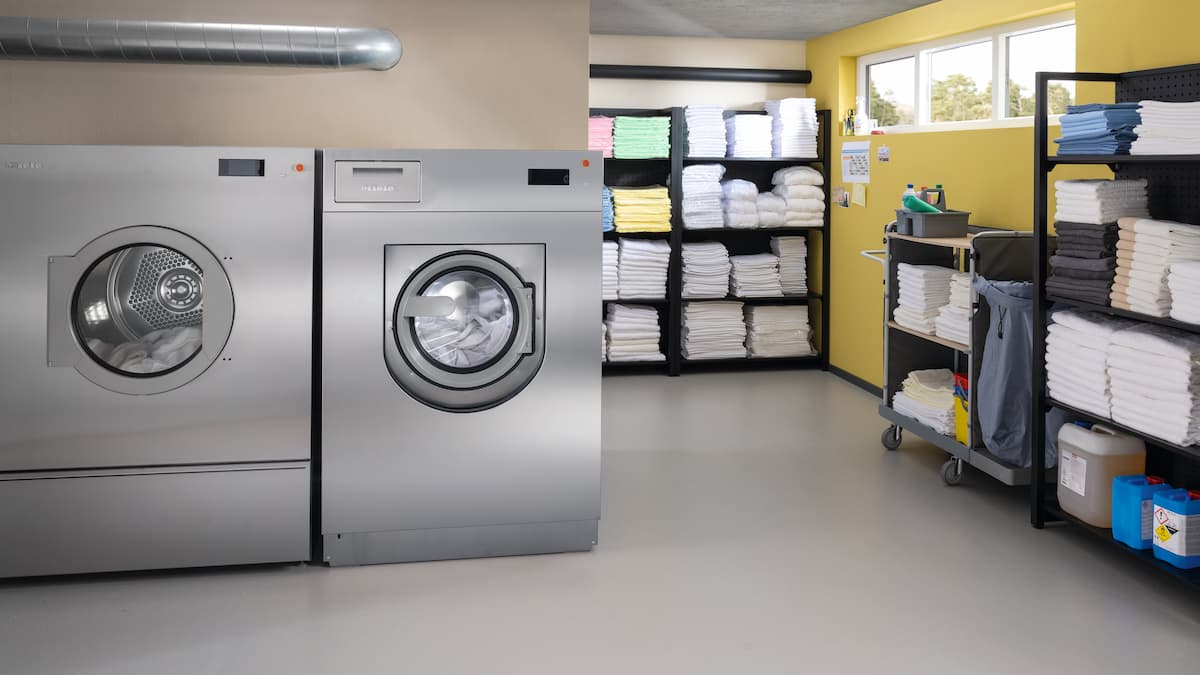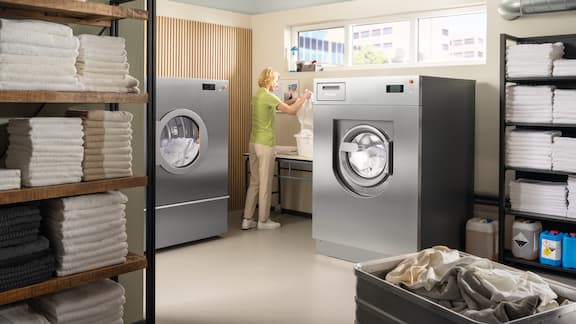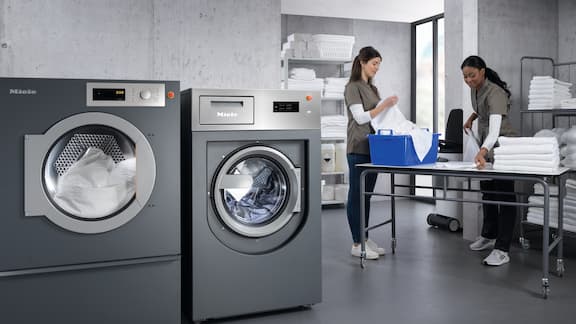
A step-by-step guide on how to build a future-ready on-premises laundry
Advantages of an OPL

OPLs offer a number of strategic advantages when compared to outsourcing:
- Control: You manage the entire process, allowing for greater control over quality and hygiene, as well as reducing turnaround times, without relying on third-party schedules.
- Consistency: In-house laundry operations allow for tailored processes that suit your specific textiles, volumes, and quality expectations.
- Cost: While the initial investment may be a barrier, long-term savings often outweigh the costs of outsourcing to a third-party.
- Efficiency: Investing in professional laundry machines can significantly streamline operations and also eliminate transport from outsourcing, reducing long-term costs and emissions.
Step 1: Evaluate your commercial laundry needs
Every OPL should begin with a clear understanding of your businesses’ needs, and how having this facility can support you. It’s important to consider:
- Laundry volume: How much laundry do you process daily, or weekly?
- Textile types: Are you handling delicate fabrics, uniforms, bedding, or a mix?
- Space: What sort of space do you have available to fit your machinery?
By being clear on these requirements, you can help ensure that the solution you choose will fully meet your laundry needs.
Step 2: Embrace smart technology and connectivity

Modern OPLs thrive on intelligent systems. Today’s commercial washing machines, such as those in our Benchmark range feature programmable wash cycles, intuitive controls, and real-time performance monitoring. And when paired with digital solutions like Miele MOVE Connect, operators and managers gain full transparency over machine usage, energy consumption and service needs.
Connectivity also means faster service response. In the event of a fault or breakdown, our service partners can be alerted instantly, allowing for a quick turnaround and minimal downtime. This means that not only does your operation continue to run smoothly but also extends the lifespan of your equipment.
And when you consider some of the key decisions you will have to make when running an OPL, connectivity is there to help. By analysing usage data, businesses can optimise their procedures, maximise their machine's output, and even adjust staffing levels based on machine availability and performance.
Step 3: Prioritise efficiency

It’s no secret that energy and water usage are major costs in any commercial laundry operation, regardless of the sector you are operating in. Choosing equipment designed for efficiency can have a significant impact on your laundry right away. Opting for commercial washing machines that have been specifically designed for your needs is an effective way of delivering outstanding results in terms of hygiene and quality, but also whilst minimising water and energy usage.
A great example of highly efficient commercial machines can be found in our Benchmark dryer range. These machines have efficient cycles that help to reduce residual moisture by 2%, shortening drying times and saving energy. This feature translates it into real-world savings whilst also supporting your environmental commitments. Shorter cycle times are also a key consideration when looking to maximise efficiency within your OPL.
For example, Lavendio residential home in Melle, Germany, chose to bring commercial laundry operations in-house to better support residents’ individual routines and preferences. By installing their own OPL facility, they gained greater control over hygiene standards and reduced reliance on external providers. The setup also helped them lower transport-related energy costs and streamline operations, allowing staff to focus on more meaningful tasks while maintaining a homely, personalised environment.
Step 4: Maximise hygiene compliance
In hospitality, the focus lies in freshness, appearance, and textile longevity. With its patented Honeycomb drum 2.0, the Benchmark machines ensure the gentle, yet thorough cleaning of your textiles, preserving fabric quality so that your linens are fresh, soft and well-presented at all times.
And while hygiene regulations vary by sector, cleanliness remains a key part of the customer experience. For example, in care homes and hospitals, the focus shifts to hygiene, which is non-negotiable. By investing in professional laundry machines that offers disinfection and hygiene programmes, you have complete peace of mind, especially in environments where compliance is critical.
Step 5: Look for flexibility and longevity

A future-ready OPL must adapt to changing needs, especially for those looking to grow their business. Whether you’re expanding your facility or adjusting to meet seasonal demands, investing in commercial machines can help support your scalability.
One of the most significant challenges for OPLs is the potential for equipment breakdown. Finding a trusted service provider who can make life much easier. Our service technicians are trained to keep your machines running at peak performance, whether it’s through proactive maintenance, expert repairs, or responsive support when you need it most.
Ready to take control?
Building a future-ready OPL means having the flexibility to adapt to changing demands, the tools to drive operational efficiency, and the confidence that your laundry operation is aligned with your long-term business goals. With the right setup, your OPL can become a strategic asset that supports everything from cost control and compliance to customer satisfaction and environmental responsibility.
If you're curious about the Benchmark range and how it works in practice, check out our other blogs and discover how they can help future proof your commercial laundry operations.
- 1.Internal knowledge

